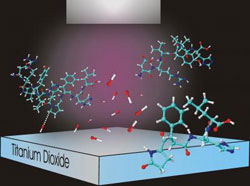Titanium dioxide — It slices, it dices …

Illustration of the cleavage of proteins near a titanium dioxide surface: when illuminated with ultraviolet light, hydroxyl radicals are formed in water near the semiconductor's surface and cut proteins at the location of the amino acid proline. Credit: NIST
Because most proteins are very large, complex molecules made up of hundreds or thousands of amino acids, they usually must be cut up into more manageable pieces for analysis. Today, this most commonly is done by using special enzymes called “proteases” that sever the chains at well-known locations. The protease trypsin, for example, cuts proteins at the locations of the amino acids lysine and arginine. Analyzing the residual fragments can identify the original protein. But enzymes are notoriously fussy, demanding fairly tight control of temperature and acidity, and the enzymatic cutting process can be time-consuming, from a matter of hours to days.
For a “radically” different approach, the NIST group turned to a semiconductor material, titanium dioxide. Titanium dioxide is a photocatalyst—when exposed to ultraviolet light its surface becomes highly oxidizing, converting nearby water molecules into hydroxyl radicals, a short-lived, highly reactive chemical species.** In the NIST experiments, titanium dioxide coatings were applied to a variety of typical microanalysis devices, including microfluidic channels and silica beads in a microflow reactor. Shining a strong UV light on the area, in the presence of a protein solution, creates a small “cleavage zone” of hydroxyl radicals that rapidly cut nearby proteins at the locations of the amino acid proline.
Although development work remains to be done, according to the researchers, the NIST photocatalysis technique offers several advantages over conventional enzyme cleavage of proteins. It’s not particularly sensitive to temperature or acidity, and needs no additional reagents other than dissolved oxygen in the solution. It’s a simple arrangement, easy to incorporate into a wide range of instruments and devices, and titanium dioxide, an inorganic material, will last virtually forever in a broad range of conditions—enzymes have to be treated carefully and stored in temperature-controlled environments. The target amino acid, proline, is relatively sparse in most proteins, but it’s found at key locations, such as sharp turns in the molecule, that aid analysis. And it’s fast—in trials with the protein angiotensin I, the team obtained detectable cleavage patterns in as little as 10 seconds.
Media Contact
More Information:
http://www.nist.govAll latest news from the category: Life Sciences and Chemistry
Articles and reports from the Life Sciences and chemistry area deal with applied and basic research into modern biology, chemistry and human medicine.
Valuable information can be found on a range of life sciences fields including bacteriology, biochemistry, bionics, bioinformatics, biophysics, biotechnology, genetics, geobotany, human biology, marine biology, microbiology, molecular biology, cellular biology, zoology, bioinorganic chemistry, microchemistry and environmental chemistry.
Newest articles

Silicon Carbide Innovation Alliance to drive industrial-scale semiconductor work
Known for its ability to withstand extreme environments and high voltages, silicon carbide (SiC) is a semiconducting material made up of silicon and carbon atoms arranged into crystals that is…

New SPECT/CT technique shows impressive biomarker identification
…offers increased access for prostate cancer patients. A novel SPECT/CT acquisition method can accurately detect radiopharmaceutical biodistribution in a convenient manner for prostate cancer patients, opening the door for more…

How 3D printers can give robots a soft touch
Soft skin coverings and touch sensors have emerged as a promising feature for robots that are both safer and more intuitive for human interaction, but they are expensive and difficult…





















